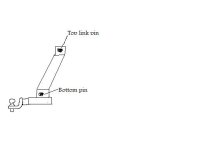jenkinsph
Super Star Member
Measure the vertical distance between the lower and upper link as mentioned gets you close.
To ge it to track level from the ground to the fully raised position you need the top link arm to be the same length as the lower arms.
Depending on the implement this may not allow enough ground clearance if you have to traverse hills or terrace rows.
Steve
To ge it to track level from the ground to the fully raised position you need the top link arm to be the same length as the lower arms.
Depending on the implement this may not allow enough ground clearance if you have to traverse hills or terrace rows.
Steve
